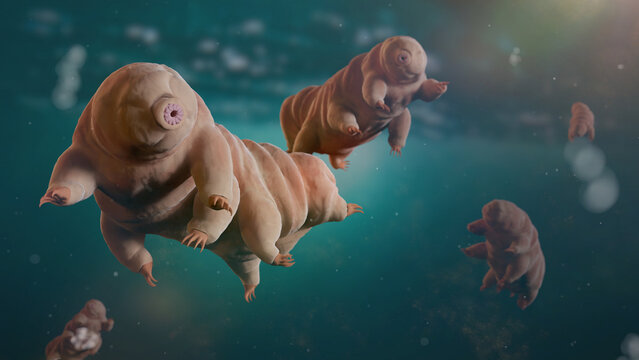Overview
Tardigrades are microscopic, eight-legged invertebrates belonging to the phylum Tardigrada. First described in 1773 by German zoologist Johann August Ephraim Goeze, who referred to them as "kleiner Wasserbär" (little water bear), they have since been colloquially known as water bears or moss piglets. The name "Tardigrada," meaning "slow stepper," was later assigned by Italian biologist Lazzaro Spallanzani in 1776. (en.wikipedia.org)
Morphology
Typically measuring between 0.3 to 0.5 millimeters in length, tardigrades possess a segmented body with four pairs of unjointed legs, each ending in claws or suction discs. Their bodies are covered by a cuticle that they periodically shed during molting. Lacking specialized respiratory and circulatory systems, they rely on diffusion for gas exchange and nutrient distribution. (britannica.com)
Habitat and Distribution
Tardigrades are cosmopolitan, inhabiting a wide range of environments including deep-sea trenches, high mountain ranges, rainforests, and the Antarctic. They are commonly found in moist terrestrial habitats such as mosses, lichens, leaf litter, and soil, as well as in freshwater and marine ecosystems. (en.wikipedia.org)
Diet and Feeding
Tardigrades exhibit diverse feeding habits. Many species are herbivorous, feeding on plant cells by piercing them with specialized mouthparts called stylets and extracting the contents. Others are carnivorous, preying on smaller invertebrates, including other tardigrades. (britannica.com)
Reproduction
Reproductive strategies among tardigrades vary. Some species reproduce sexually, with males fertilizing females' eggs, while others reproduce asexually through parthenogenesis. Females may lay eggs within their molted cuticles, providing protection until hatching. (nationalgeographic.com)
Survival Mechanisms
Tardigrades are renowned for their ability to survive extreme conditions that would be lethal to most other life forms. They can endure temperatures ranging from close to absolute zero to over 150°C, pressures six times greater than those found in the deepest ocean trenches, and high levels of radiation. (sciencefocus.com)
A key to their resilience is cryptobiosis, a state of suspended animation induced by desiccation. In this state, tardigrades lose almost all body water, retract their limbs, and form a "tun." This state allows them to withstand harsh conditions for extended periods. (britannica.com)
Space Resilience
Tardigrades have demonstrated the ability to survive the vacuum and radiation of outer space. In 2007, dehydrated tardigrades were exposed to space conditions for 10 days aboard the FOTON-M3 mission. Upon return to Earth, many were successfully revived and even reproduced. (nationalgeographic.com)
Genetic Adaptations
Research has identified unique proteins in tardigrades, such as Dsup (damage suppressor), which protect their DNA from radiation-induced damage. Additionally, tardigrades produce intrinsically disordered proteins that form a glass-like matrix during desiccation, stabilizing cellular components. (sciencefocus.com)
Taxonomy
The phylum Tardigrada comprises approximately 1,500 known species, divided into classes such as Eutardigrada and Heterotardigrada. They are part of the superphylum Ecdysozoa, which also includes arthropods and nematodes. (en.wikipedia.org)
Research and Applications
The resilience of tardigrades has implications for various scientific fields, including astrobiology, genetics, and biotechnology. Understanding their survival mechanisms may contribute to advancements in medicine, agriculture, and the development of materials capable of withstanding extreme conditions. (sciencefocus.com)
